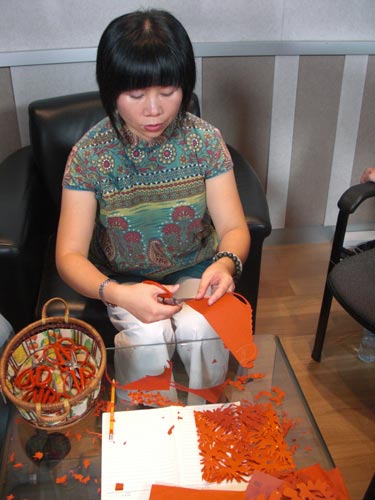|

Paper cutting expert and teacher Pan Xiaomin displays her skills. [Photo: CRIENGLISH.com]
Paper cutting is the art of creating patterns, designs or pictures by using scissors to cut paper in various ways. It originated in China after the invention of paper in around 100 BC.
As paper was rare and precious in its early days, paper cutting first became popular among court ladies in royal palaces and houses of nobility. Later on paper cutting became a widespread folk art throughout China and an integral part of many festivals and celebrations.
Paper cuts are still widely used to decorate windows, interiors, gates and doors in the middle kingdom, particularly during Spring Festival time. They are also produced and displayed during other festivities and wedding celebrations.
Recently I had the opportunity to join some colleagues and learn some paper cutting basics from Pan Xiaomin, an expert with a major in art education and over fifteen years teaching experience. She teaches a cultural course in paper cutting to international students at the Beijing language and culture University and also leads classes for local children and adults.
During our first lesson we practiced the first two basic cuts, the straight edge cut and the curved cut. First we folded our paper over and over again, then took our scissors and cut into it. Pieces of paper were fluttering all around as we tried to follow our teacher's lead. It soon became obvious that her effortless manoeuvring of the scissors and paper would take some time to emulate.
Both hands and all of your fingers should work together when cutting the paper and there's a special way to hold what you have in your hands. Naturally the aim is to control both paper and scissors and allow them to work in unison. Unfortunately, this is easier said than done.
All scissors are not created equal when it comes to paper cutting. Those with wide spacious grips should be used because the wider the finger grips the more fingers can be used to control the cutting and the less tired you will become.
While following the teacher's lead and cutting the paper I found it hard to imagine what my paper cut could eventually look like. This only added to the excitement of finally opening it out to reveal a kaleidoscopic pattern created by my random incisions. I can only imagine the excitement of actually creating an animal or a scene by cutting the paper.
Paper cuts are not only fun to make but a pleasure to collect and admire and for the experienced cutter the range of images is only limited by the imagination. Ms Pan's most advanced students are now combining paper cuts with animation and breathing new life into this ancient art form.
I'm now looking forward to my next lesson when I can learn more of the necessary paper cutting skills. However, while it may be relatively easy to learn about making initial cuts to a piece of paper, I now know it's far more difficult to master these skills with perfection.
|
 涓枃绠€浣?/a>銆€|銆€
涓枃绠€浣?/a>銆€|銆€











